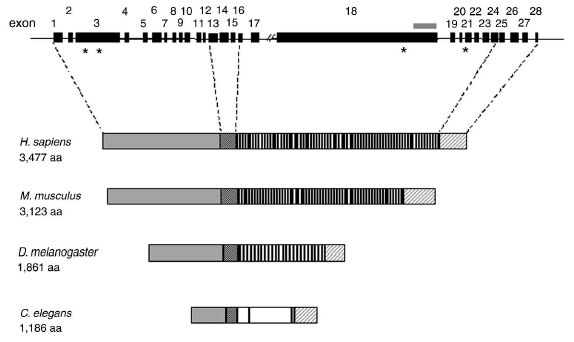
- This web page was produced as an assignment for an undergraduate course at Davidson College -
The Big Brain Gene
"ASPM is a major determinant of cerebral cortical size"
Nature Genetics
Microcephaly is a condition describing an abnormally small head and congenitally small brain. Despite dramatic reduction in cerebral cortical size, microcephalic persons usually only suffer from mild mental retardation, if any. While microcephaly is a symptom of several different genetic conditions (such as achondroplasia and other forms of dwarfism), primary microcephaly may be caused by a single genetic mutation. Five recessive loci have been identified as causing primary microcephaly (MCPH1-5); all five mutations produce indistinguishable clinical manifestations (Kumar et al., 2002). In this article from Nature Genetics, the authors used positional cloning and other molecular techniques to identify the most common mutation, MCPH5 (Bond et al., 2002).
The trait was first realized amongst a consanguineous Pakistani tribe in which 24 of 56 families contained an individual with microcephaly. The team had previously identified an 8 megabase region of 1q31 which contained MCPH5. Using inheritance data, lod scores, and microsatellites the researchers narrowed the region of interest to a 600 kilobase segment containing four candidate genes. After cloning and sequencing, one gene- ASPM (abnormal spindle-like microcephaly associated) - was found to have a premature stop codon in the open reading frame of each family.
It was found that many vertebrate organisms have a well-conserved version of the ASPM gene (see map below). In fact, the gene was first discovered in Drosophila (asp) and named for the abnormal-spindle phenotype researchers observed. It was later found that asp is involved in microtubule organization during various mitotic and meiotic functions (Wakefield et al., 2001). Ironically, the researchers noticed a correlation between an organism's neural complexity and the size of the ASPM-like protein. N-terminal and C-terminal regions were highly conserved, but the middle portion of the peptide varied between organisms. Specifically, the correlation seemed to be related to the number of IQ domains - a repeated isoleucine-glutamine region - that function as a calmodulin-binding domain (Craig and Norbury, 1998). The specific effects of an increased number of IQ repeats is unknown, although this paper does suggest that these areas contribute directly to neural development and brain size.
Undoubtedly, brain size and function are important traits related to an organism's evolutionary advantage. Identification of genes which impact neural development is beneficial when tracing evolutionary lineages. The researchers have described an interesting phenomenon whereby a repeated sequence in this spindle-associated protein correlates with levels of brain function.

Predicted ASPM homologous proteins in various species. Note the varying size of the peptide as well as the IQ domain indicated by vertical bars.
(From Bond et al., 2002. Permission requested.)
New York Times
Perhaps the most noticeable feature of this popular press article is the clarity of language. While the scientific article contained enough technical jargon to dismay any reader without a genetics background, the Times article superbly related the findings in plain English (Wade, 2002). For example, the author describes the concept of a premature stop codon and truncated protein: "the gene... carried a one-letter change, or mutation, in the DNA sequence. The mutations produced an inadvertent stop signal in the gene, causing the cell to make a cut-down version of the gene's normal protein." In this short paragraph the author quickly communicated an important biological concept to a general non-science audience.
Another impressive aspect of the popular press article is the unusual restraint used when reporting the findings. For example, although "IQ domain" refers to a repeated amino acid sequence, the temptation exists to make a hokey claim like "IQ is a genetic phenomenon," or "IQ determines IQ!" The author specifically mentions that "[IQ] has nothing to do with intelligence but refers to two chemical units of proteins that are known by those letters." Other popular press reporters may not have exhibited the same amount of journalistic maturity in drafting this article.
Finally, it should be noted that in one particular aspect, the popular press article is perhaps more scientific than the actual Nature Genetics paper. The headline for the Times paper claims that "Brain Size is Linked to a Gene," which is correct and can be scientifically validated using the genetic mapping techniques described in the paper. However, the Nature Genetics paper claims that "ASPM is a major determinant of cerebral cortical size." Most bothersome is the word "major," a qualitative assessment that is not assessed in the paper. A more conservative title may have foregone the word "major" to best describe the paper's findings. It must be noted, however, that we can not know if this title was devised by the authors or the editors, as scientific journal publishing companies are often pressed to print more provocative titles to increase sales and circulation.
Selected Links
Caenorhabditis elegans T30148
Drosophila melanogaster NP 524488
Mus musculus NP 033921
Homo sapiens NP 060606
OMIM entry for ASPM *605481
References
Bond J et al. (2002) ASPM is a major determinant of cerebral cortical size. Nature Genetics. 32: 316-320. (Abstract or PDF)
Craig R and Norbury C. (1998) The novel murine calmodulin-binding protein Sha1 disrupts mitotic spindle replication checkpoint functions in fission yeast. J Cell Sci. 111: 3609-19. (Abstract)
Kumar A et al. (2002) Primary microcephaly: microcephalin and ASPM determine the size of the human brain. J Biosci. 27: 629-32. (Abstract)
Wade N. (2002) Brain Size is Linked to a Gene. New York Times. 24 Sept 2002. (Abstract)
Wakefield et al. (2001) The Drosophila gene asp is involved in microtubule organization during spindle formation and cytokenesis. J Cell Bio. 153: 637-48. (Abstract)

Pinky and the Brain. One is a genius, the other's insane.
This page created by: Gray Lyons
![]()
Return to My Genomics Page
Return to the Genomics Course Homepage
Return to the Davidson College Homepage